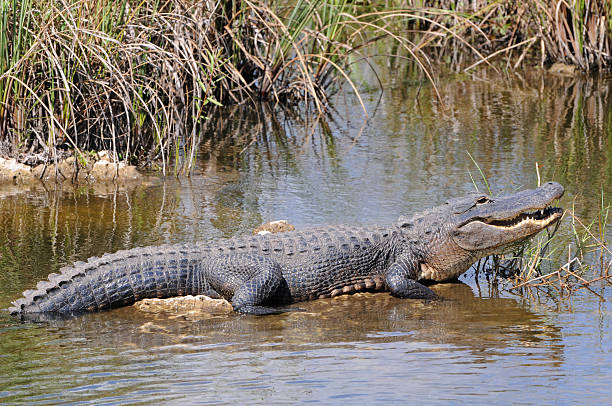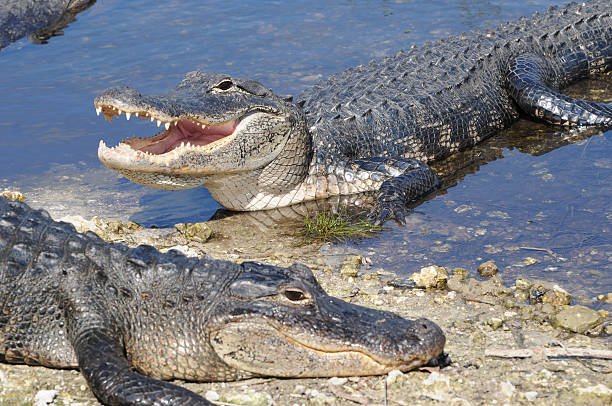Table of Contents
Scientific Classification
| Kingdom | Animalia |
| Phylum | Chordata |
| Class | Reptilia |
| Order | Crocodylia |
| Family | Alligatoridae |
| Genus | Alligator |
| Species | Alligator mississippiensis |
| Scientific Name | Alligator mississippiensis |
Description
The American Alligator (Alligator mississippiensis) is a large, semi-aquatic reptile found in the southeastern United States. As an apex predator, it is recognized for its powerful jaws, muscular build, and tough skin, playing a vital role in its ecosystem. Adults usually measure between 3 to 4.5 meters (10 to 15 feet) in length and can weigh over 450 kg (1,000 lbs).
You can distinguish alligators from crocodiles by their broad, U-shaped snouts and darker, almost black coloration. Their eyes and nostrils are positioned high on their heads, allowing them to breathe and see while mostly submerged in water.
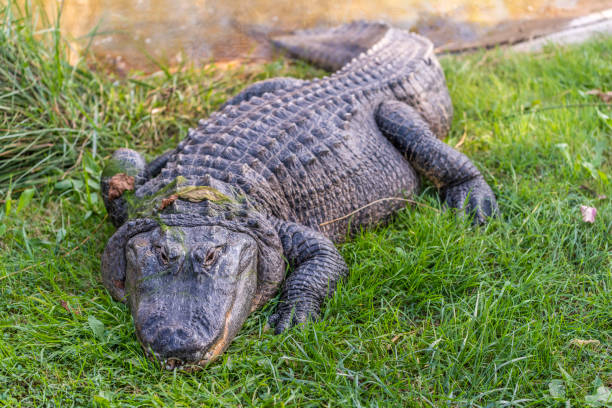
Distribution
The American Alligator is primarily found in the southeastern United States, particularly in:
Florida
Louisiana (home to the largest population)
Georgia
Alabama
Mississippi
South Carolina
North Carolina
They inhabit freshwater environments, preferring slow-moving rivers, swamps, lakes, and marshes.
Habitat
American Alligators live well in freshwater wetlands. They are important for keeping the ecological balance. They are commonly found in:
Swamps and marshes – Ideal for nesting and hunting.
Lakes and ponds – Providing year-round water access.
Rivers and slow-moving streams – Allowing easy mobility and feeding opportunities.
Man-made canals and reservoirs – Adapting well to human-altered environments.
Despite their preference for freshwater, alligators occasionally tolerate brackish water near coastal regions.
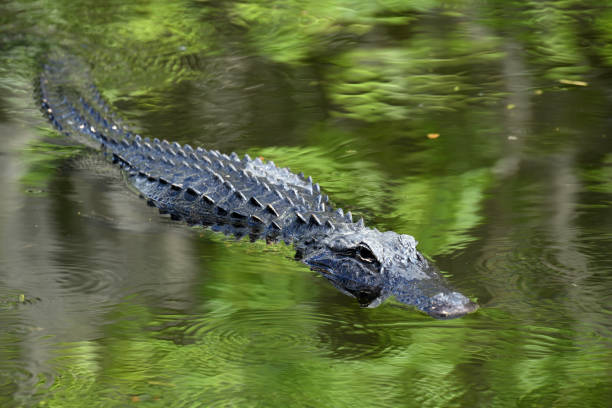
Diet
American alligators are opportunistic carnivores, and their diet evolves as they grow older and larger.
Juveniles primarily eat insects, amphibians, small fish, and crustaceans.
As they transition to sub-adults, they start consuming larger fish, turtles, birds, and small mammals.
Once they reach adulthood, they target even larger prey, such as deer, wild boars, and occasionally other alligators.
Their hunting strategy involves a “sit-and-wait” approach, where they ambush their prey with a powerful lunge followed by a bone-crushing bite. They are also known to scavenge carrion when the opportunity arises.
Behavior
American Alligators typically prefer solitude, but they exhibit social behaviors during the breeding season. These behaviors include:
Basking – They sunbathe on riverbanks to regulate their body temperature.
Bellowing – Males create deep vocalizations to establish their territory and attract potential mates.
Burrowing – They dig “gator holes” that hold water and offer refuge during dry spells.
Night Hunting – With their excellent night vision, they ambush prey in the dark.
Alligators are territorial and will defend their home against intruders, including other alligators.
Lifespan
American Alligators have a long lifespan. In the wild, they typically live between 35 and 50 years. However, in captivity, they can live for more than 60 to 80 years, thanks to consistent food and medical care.
Reproduction and Lifecycle
Reproduction plays a crucial role in the lifecycle of alligators, ensuring the continuation of the species.
Nesting – Female alligators build nests using vegetation and mud, where they lay between 20 and 50 eggs.
Incubation – This period lasts around 60 to 70 days, and the temperature of the nest influences the sex of the hatchlings.
Hatchlings – They typically emerge in late summer, measuring about 15 to 20 cm (6 to 8 inches) in length.
Maternal Care – Mothers protect their young for nearly a year, keeping them safe from potential threats.
Unfortunately, many hatchlings fall victim to birds, raccoons, and larger alligators, which impacts their survival rates.
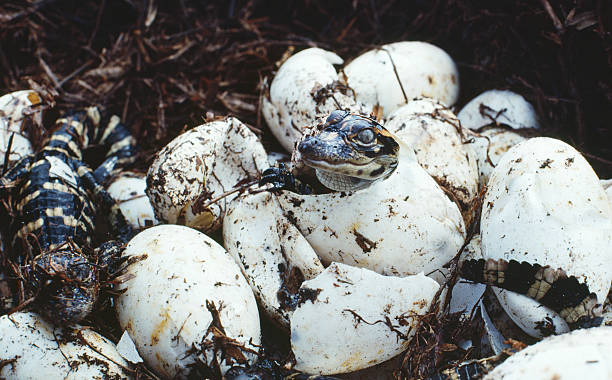
Predators
Adult American Alligators have few natural predators due to their size and strength. However, younger individuals are at risk from:
Birds of prey – Such as herons and eagles.
Fish and turtles – Larger species prey on hatchlings.
Mammals – Raccoons frequently raid alligator nests.
Other Alligators – Cannibalism occurs when food is scarce.
Humans remain their greatest threat due to habitat destruction and hunting.
Adaptations
American Alligators possess several adaptations that make them formidable survivors:
Powerful Jaws – Exerting up to 2,125 psi of bite force, capable of crushing bones and turtle shells.
Camouflage – Dark, rough skin helps them blend into murky waters.
Aquatic Efficiency – Webbed feet and a strong tail enable swift swimming.
Nictitating Membrane – A transparent third eyelid protects their eyes underwater.
This is different from crocodiles.
These adaptations make them one of the most resilient reptilian species.
Conservation Status
The American Alligator faced endangerment in the past because of excessive hunting for its skin and meat. However, thanks to various conservation efforts, its status has improved significantly. Currently, the IUCN classifies it as Least Concern.
Conservation Efforts:
Strict Hunting Regulations – Enforced to avoid overexploitation.
Habitat Protection – Conservation of wetlands supports sustainable populations.
Breeding Programs – Initiatives for captive breeding help preserve genetic diversity.
Public Awareness Campaigns – Informing communities about living alongside alligators.
The American Alligator stands as a success story in wildlife conservation, attributed to these initiatives.
Conclusion
The American Alligator stands as a testament to resilience and ecological significance. As apex predators, they play a crucial role in controlling prey populations and shaping wetland ecosystems. Once on the brink of extinction, conservation initiatives have successfully increased their numbers. Today, they flourish in their natural habitats.
The American Alligator is an extraordinary reptile. Its impressive adaptations and intricate behaviors are essential to the ecosystem, which adds to its intrigue. People globally admire and hold this creature in high regard.
